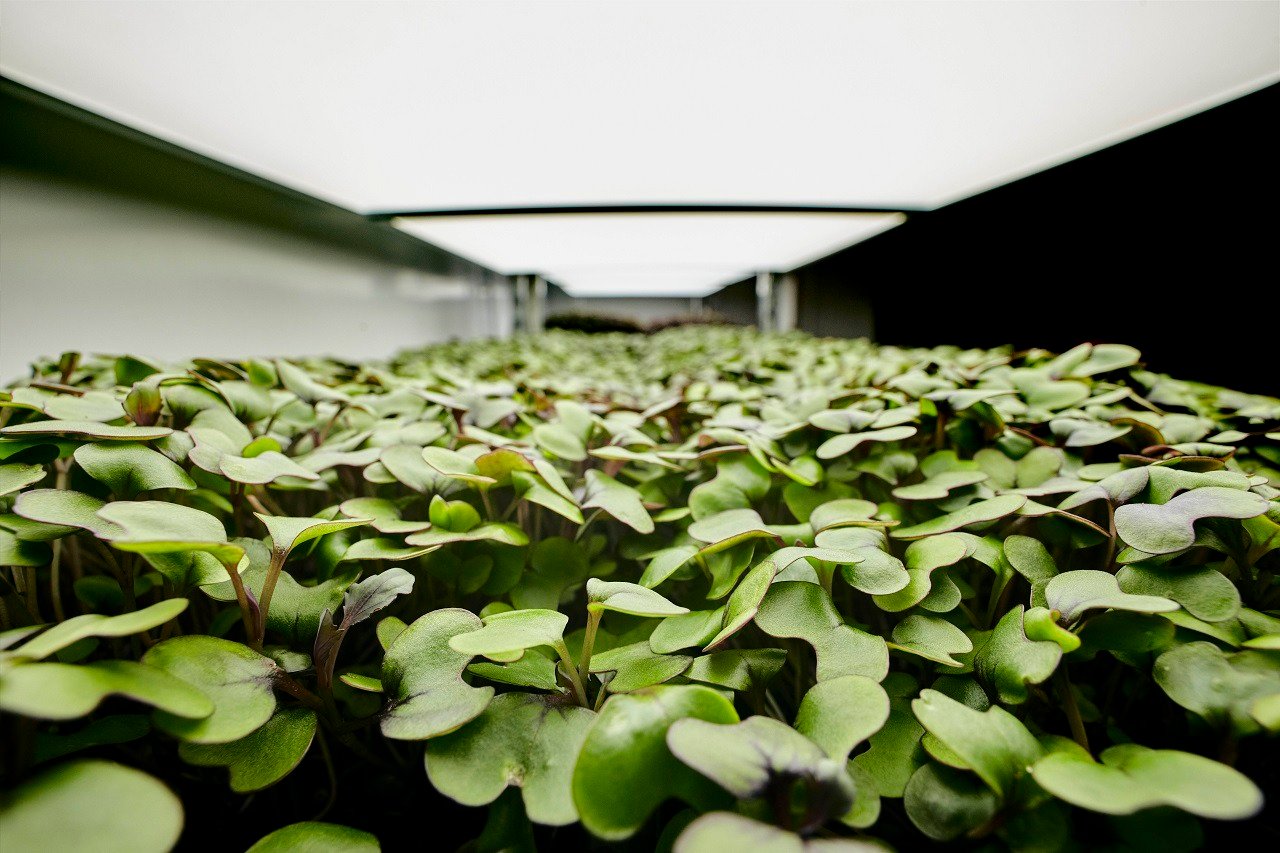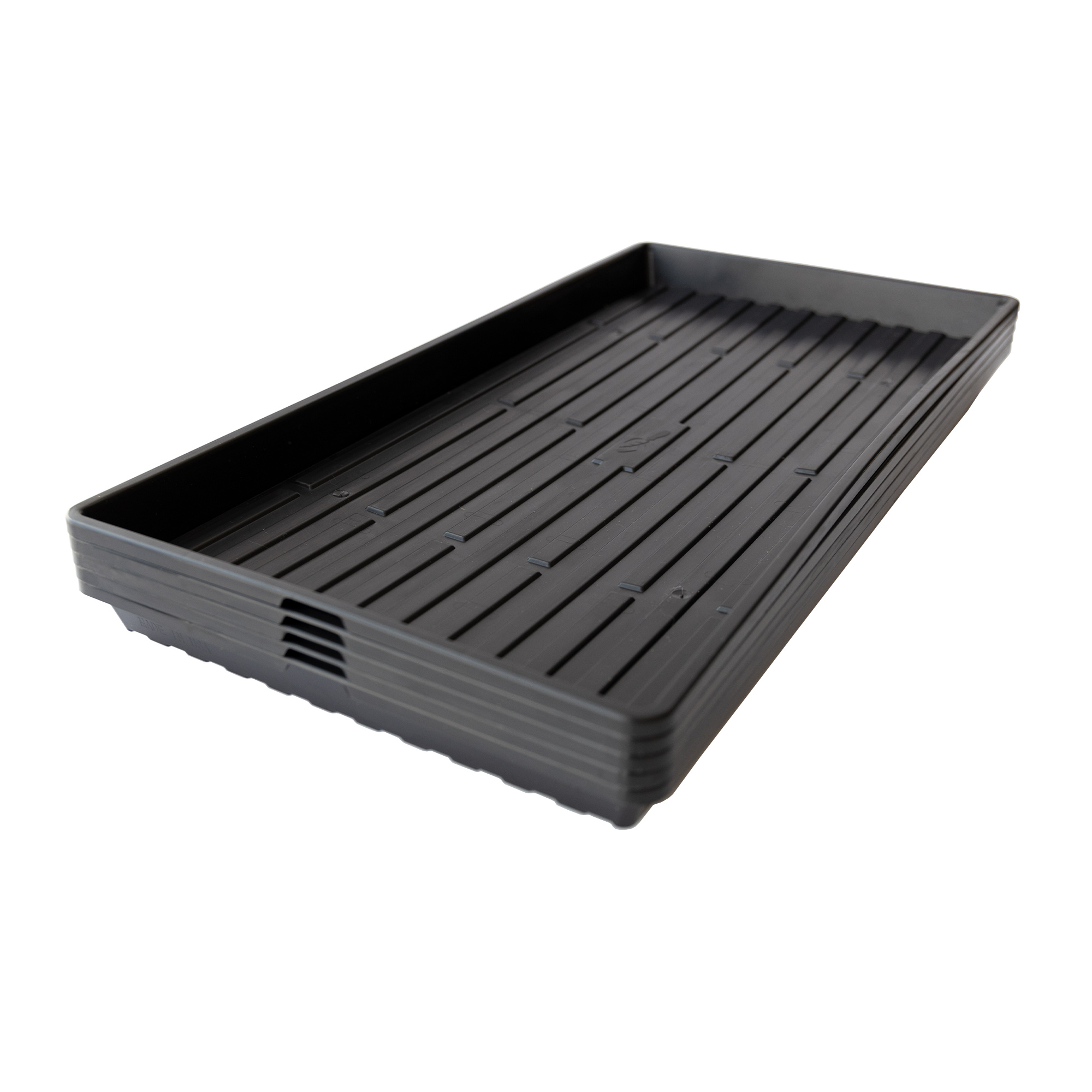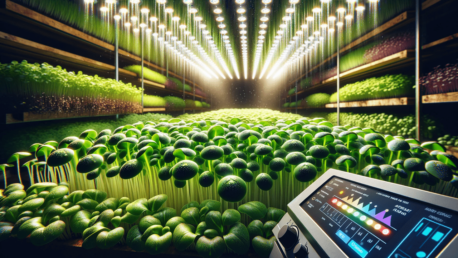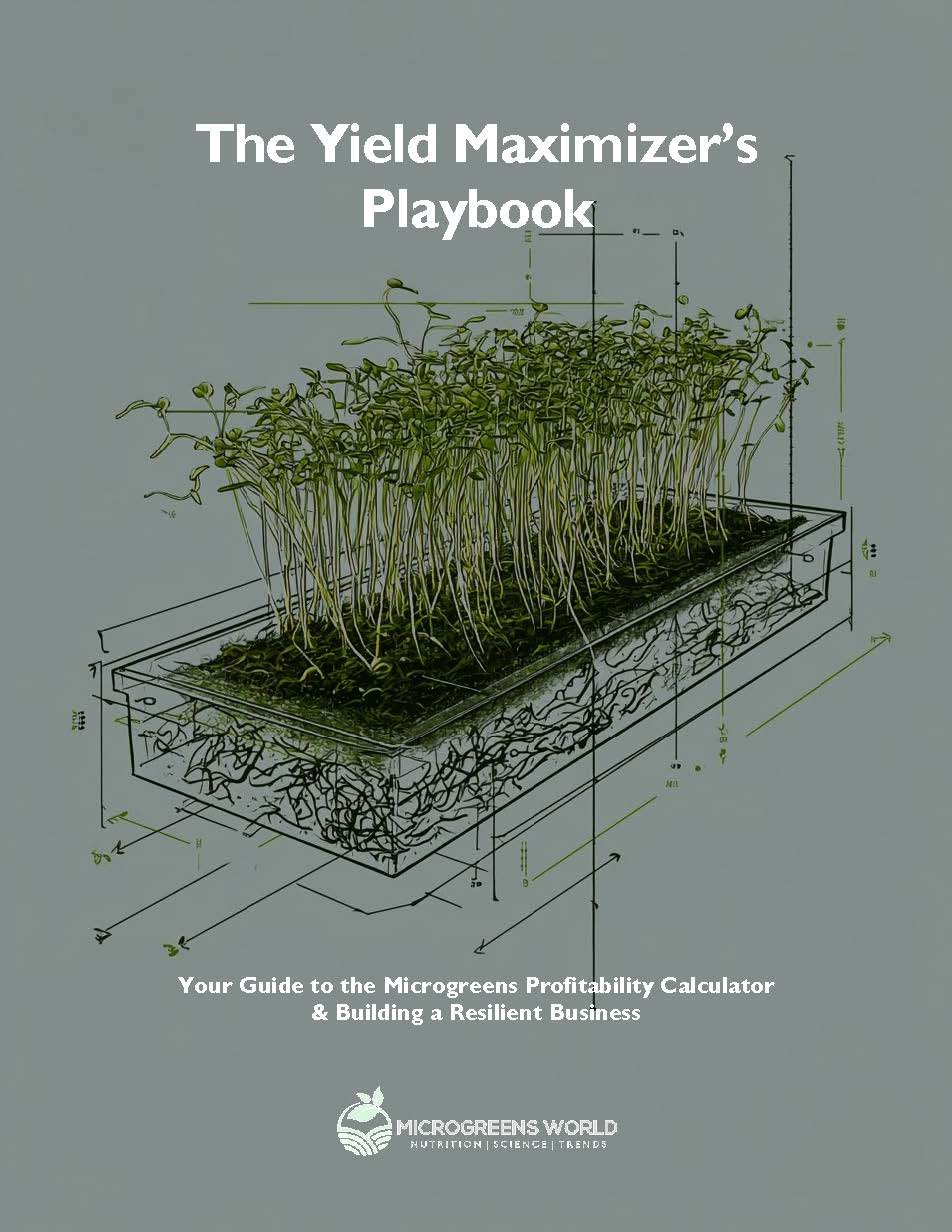Crop planning is an essential skill for every farm business person. Embarking on our microgreens crop planning journey, Stephen and I discovered the intricate art of cultivating these nutrient-rich greens. Our initial foray into growing microgreens in the basement of Stephen’s home quickly evolved into a passion driven by the complexities and rewards of sustainable agriculture. It was through meticulous planning and learning about each plant’s unique needs that we transformed our hobby into a thriving venture.
Microgreens crop planning is a strategic process involving selecting varieties, scheduling planting, and determining quantities based on customer orders and market demand. It encompasses setting growth objectives, ordering seeds, and systematically tracking cultivation, processing, and maintenance tasks to inform future cultivation cycles.
We further refined our approach after meeting the Corwin brothers at Piedmont Microgreens, who introduced us to the nuances of efficiently managing cultivation cycles using their Microgreen Manager software [1]. This experience underscored the importance of a structured plan, not just for daily tasks but also for adapting to market demands.
Microgreens crop planning, a precise process of selecting crops, timing plantings, and estimating quantities, became our blueprint for balancing our market needs with nature’s rhythms.
In this post, we explore the importance of crop planning using crop planning software. It is a vital first step in your goal to scale your startup into a viable and profitable microgreens business.
Stay with me, and take your business planning to the next level.
Importance of Effective Microgreens Crop Planning
Setting Objectives for Microgreens Cultivation
Deciding What Microgreens to Grow
Timing and Scheduling for Planting
Crop Maps and Plots, Racks and Trays
Quantity Planning: How Much to Grow
Seed Selection and Ordering
Embracing Technology in Microgreens Farming
Creating a Microgreens Growing Checklist
Processing and Maintenance Tasks
Record-keeping and Note-Taking
Planning for the Next Growing Period
Key Takeaways for Microgreens Crop Planning
References

Importance of Effective Microgreens Crop Planning
Microgreens have rapidly gained popularity due to their nutritional value and culinary versatility, presenting exciting prospects for growers. They are an emerging product developed from various commercial food crops, such as vegetables, grains, and herbs. They have undergone extensive scientific and commercial research in the last five years [16].
Market trends indicate a growing demand for these nutrient-rich greens, especially among health-conscious consumers and culinary professionals [15]. The global microgreens market is poised for significant growth of USD 100 billion over the next five years (2024-2028). This is an exciting time if you are a microgreens grower.
If you are new to microgreen cultivation, delving into comprehensive resources on Microgreens World, like the various articles on growing, and my book, “Your 9-Day Blueprint to Microgreen Mastery” is advisable to grasp the fundamental concepts of growing these plants.
Consisting of developed cotyledons and partially expanded true leaves, harvesting of these immature plants occurs between 7 and 21 days of seed sowing (depending on the plant type). They pose unique and exciting challenges in crop planning.
Crop Planning Fundamentals
Effective crop planning is fundamental to successfully cultivating microgreens. It’s more than mere seed sowing, demanding a strategic approach to ensure optimal yield and cost efficiency. Proper planning is essential to determine the correct quantity and variety of microgreens you need to grow, aligning with local market demand and growing conditions. This strategic approach is crucial for yield optimization, ensuring that each batch of your microgreens meets the expected quality and quantity standards.
Efficient crop planning can significantly influence yield and profitability in the competitive microgreens market. Growers who adeptly plan their crops can achieve better market positioning and profitability. You will need a deep understanding of market trends, customer preferences, and efficient resource management—long-term sustainability in microgreen farming hinges on adapting and planning according to evolving market needs and environmental conditions.
Tools like Microgreen Manager software are invaluable in streamlining this complex process for you. Microgreen Manager is indispensable in planning, managing, and optimizing your microgreen farm. Microgreen Manager provides a platform to enter, track, and adjust one-off and recurring orders with your clients. When you enter your orders, the software automatically calculates the trays needed to fulfill the demand. Microgreen Manager will also list every task needed to prepare, plant, and grow those trays on time.
This level of organization and efficiency is crucial whether you are a seasoned farmer or a microgreens newcomer.
As we delve deeper into microgreens crop planning, remember that successful farming starts with meticulous planning and a deep understanding of these tiny yet mighty greens.
Setting Objectives for Microgreens Cultivation
The success of your microgreen cultivation hinges on setting clear, informed objectives–understanding market demand, aligning it with your personal farming goals, and balancing variety and quantity.
Identifying Market Demand
You must understand buyer and consumer preferences to cater to your market effectively. You begin by surveying local markets, such as farmers’ markets, restaurants, and grocery stores, to gauge what microgreens are in demand. Are buyers and consumers looking for common varieties like radish and pea, or are they interested in more exotic options like amaranth? Engaging directly with customers or working with local chefs can provide valuable insights into consumer preferences.
Online market analysis is another crucial tool. Analyzing trends on social media, food blogs, and online marketplaces can offer a broader perspective on what your local consumers are looking for. This research can reveal emerging trends that might not yet be evident in your local market.
Analyzing market trends involves understanding the ebb and flow of demand throughout the year. Seasonal variations can significantly impact consumer interest in certain types of microgreens. For instance, lighter, salad-friendly varieties may be more prevalent in spring and summer, while heartier greens could have increased demand in colder months. Keeping an eye on emerging consumer interests, such as a growing preference for organic or locally sourced produce, can also guide your cultivation strategy.
Personal Farming Goals
Setting yield targets is critical in aligning your production with market demand. These targets involve estimating the space and resources you have available, such as growing areas, lighting, and staffing. Setting realistic targets that match your capacity while meeting market needs is essential.
Balancing quality with quantity is a delicate dance. High-quality microgreens can command a better price and strengthen your brand but they also require more attention and resources. Implementing quality control measures, such as regular monitoring and adjusting growing conditions, is critical to maintaining high standards. Moreover, the challenge is to scale up production to meet demand without sacrificing quality. You must carefully plan and use resources efficiently.
Balancing Variety and Quantity
Diversification strategies in microgreen cultivation involve growing a range of varieties to cater to different market segments. As your business grows, this broadens your customer base and mitigates risk; if one crop fails or is less in demand, others can compensate.
Crop rotation, where you recycle the soil from each harvest and plant different microgreens in succession, can benefit soil health and reduce the risk of pest and disease buildup.
Managing crop rotation requires a deep understanding of each variety’s growth requirements and impact on the soil. Some microgreens, like peas, can enrich the soil with nitrogen, benefiting subsequent crops. On the contrary, nutrient depletion and increased susceptibility to pests and diseases can be caused by repeated cultivation of a single variety within that area. Therefore, rotating crops not only diversifies your product range and contributes to sustainable farming practices, but it is also a cost management tool as well.
In summary, setting objectives for microgreen cultivation is a multifaceted process that involves understanding market demand, aligning it with your farming capabilities, and strategically planning your crop variety and volume. By doing so, you can create a sustainable, profitable microgreen farming operation that meets consumer needs and aligns with your personal and business goals.
Deciding What Microgreens to Grow
Choosing the right microgreens to cultivate is an essential decision with a significant impact on the success of your farming venture. Factors like ease of growth, market demand, and specific growing conditions should inform your choices.
Popular Varieties
Certain varieties stand out for their ease of cultivation and popularity in microgreens. Easy-to-grow options are particularly appealing if you’re starting. Beginner-friendly varieties like radish, arugula, and mustard are simple to grow, have a quick turnaround, and are typically ready for harvest within two weeks. These resilient crops require minimal care and are a great way to get acquainted with microgreens farming.
High-demand varieties, on the other hand, are those that have established a strong market presence. These include varieties like pea shoots, sunflowers, and basil. Analyzing sales data from local markets, online platforms, and customer feedback is crucial to identify these. Understanding what your customers are looking for, whether it’s for culinary use or health benefits, can guide you in choosing the suitable varieties to meet market demand.
Growing Conditions for Each Variety
Each microgreen variety has unique growing conditions that you must meet for optimal growth. Light is a critical factor in the growth of microgreens. While some varieties thrive under natural sunlight, others may require artificial lighting to achieve the best results. You can significantly affect microgreens’ growth rate and quality by moderating the intensity and duration of light exposure. For instance, lettuce microgreens prefer lower light intensities, but herbs like basil might require more intense light.
Temperature and humidity are also vital for healthy growth. Ideal growing temperatures vary between varieties, but a range of 65-75°F (18-24°C) is generally suitable for most microgreens. Managing humidity is equally important. Too much humidity leads to mold growth, while too little can dry out the plants. Employing humidity domes or a dehumidifier for seedlings can help maintain the right balance.
Exploring Niche Microgreens
Venturing into niche microgreens can be a lucrative aspect of your business. These specialty varieties, such as amaranth, shiso, or wheatgrass, offer unique selling points like unusual flavors, colors, or health benefits. They cater to a specific market segment looking for something different from the standard offerings. Organic and non-GMO microgreens are increasingly popular, appealing to health-conscious consumers and those concerned about sustainable farming practices.
Identifying the proper channels and developing effective marketing strategies is vital to marketing your niche microgreens successfully. You will want to target high-end restaurants and health food stores or participate in farmers’ markets known for selling unique gourmet products. Understanding the preferences of these niche markets and tailoring your marketing efforts to highlight the unique qualities of your microgreens can help you carve out a profitable segment in the microgreens market.
Leverage Microgreen Manager to understand what microgreen varieties are in high demand. Filter production data to see the varieties you’re growing in the highest and lowest quantities. Use this data to grow more of the favorites and less of the fringe varieties.
Timing and Scheduling for Planting
Mastering the timing and scheduling for planting microgreens is crucial for a steady and efficient harvest. You must handle their growth cycles, create a well-planned planting schedule, and consider seasonal factors.
Understanding Growth Cycles
The growth cycle of microgreens begins with the germination period, a critical phase where seeds develop into young seedlings. Optimal conditions for germination include consistent moisture, appropriate temperature, and, in some cases, specific light conditions. For instance, while some seeds require darkness to germinate, others might need light. Monitoring germination progress is essential to ensure the seeds develop as expected and involves regular checks for mold, proper moisture levels, and the first signs of sprouting.
Once germination is successful, the focus shifts to the harvesting timeframes. Determining the peak harvest time is critical to ensuring the microgreens are at their nutritional and flavor peak. As I pointed out earlier, these peaks vary among varieties; for example, radish microgreens might be ready in as little as five days, while others, like Swiss chard, may take up to two weeks. Harvesting techniques also play a role in quality and yield. Using sharp scissors or knives to cut the microgreens cleanly above the soil line ensures minimal damage and a longer shelf life.
Creating a Planting Schedule
A well-structured planting schedule is vital for maintaining a continuous harvest. Sequential planting, where you sow new seeds regularly, ensures a consistent supply of microgreens. Planning for succession planting involves calculating the growth cycle of each variety and scheduling the sowing accordingly. Managing overlapping cycles, where different varieties are simultaneously at various growth stages, requires meticulous planning and organization.
Adjusting schedules for efficiency is also essential. These adjustments include being flexible and responsive to unexpected changes, such as faster or slower growth rates than anticipated. Seasonal adjustments may also be necessary, as growth rates can vary with natural light and temperature changes throughout the year.
Microgreen Manager handles the meticulous calculations of overlapping cycles and succession plantings. Once you enter the crop information, such as the germination duration and total grow time, the software handles the rest. You never have to worry about missing a planting or not having enough product. While you’re busy finding new customers, the software provides a daily breakdown of exactly what you need to plant to ensure a steady supply of microgreens.
Seasonal Considerations
Deciding between indoor and outdoor growing is a significant consideration. Indoor growing offers more control over environmental conditions and can enable year-round production. However, it requires investment in equipment and infrastructure, like grow lights and temperature control systems. Outdoor growing in tropical or sub-tropical regions like the southern US (California, New Mexico, Arizona, Texas, Louisiana, and Florida), while dependent on natural conditions, can reduce costs and provide more space for cultivation.
Adapting to climate variations is crucial, especially for outdoor growing, primarily weather-related adjustments, such as providing shade during intense heat. Understanding and preparing for these variations ensures your microgreens thrive regardless of external conditions, leading to a successful and bountiful harvest.
Crop Maps and Plots, Racks and Trays
In traditional farming, crop maps are essential for planning and managing the spatial layout of crops in fields. However, crop mapping takes a different form in microgreen farming, where cultivation typically occurs indoors using racks and trays. It becomes more about optimizing space and managing the sequential planting of various microgreen varieties.
In microgreen farming, the ‘map’ is less about physical space and more about organizing time and resources. Each tray on a rack can be considered a ‘plot’ in this indoor farming landscape. The key is efficiently utilizing each tray and rack to maximize yield and ensure a continuous harvest. Use these trays to implement your color-coded ‘map.’
Tray and Rack Organization
Each tray represents a micro plot where various microgreens are grown. Organizing these trays on racks in a systematic manner is crucial. You could base the organization on the growth cycles of different microgreens, grouping those with similar growing times using the same color trays. For instance, you might place fast-growing varieties like radish and mustard on the same rack in blue trays, while separately grouping slower-growing varieties like beetroot or sunflower in yellow trays.
Sequential Planting and Harvesting
Like traditional farmers plan crop rotations, microgreens farmers must plan sequential planting and harvesting. You must schedule when each tray is sown and harvested. The goal is a continuous cycle of harvesting one tray and sowing another. You then ensure a steady supply of microgreens to fill orders promptly. A detailed planting schedule, which includes sowing dates, expected growth periods, and harvesting times, becomes the equivalent of a crop map in microgreens farming.
Space Optimization
In an indoor setting, space is a premium resource. Efficiently utilizing vertical space with racks and optimizing the layout of trays can significantly increase production capacity. You scale your production using multi-tiered racks and arranging trays so that each microgreen variety receives adequate light and air circulation.
Record-Keeping
Maintaining detailed records is vital in this system and integral to Good Agricultural Practices (GAP) and international standards for growing fruits and vegetables. Notes on each tray’s planting date, variety, growth progress, and harvest time are crucial. This information acts as a guide for future planting schedules and helps in identifying the most productive varieties and methods.
In summary, translating the concept of crop mapping to microgreens involves a strategic approach to tray and rack organization, meticulous planning of sequential planting and harvesting, and adequate space optimization. This indoor version of crop mapping is less about the physical layout and more about efficiently managing time, space, and resources.
Quantity Planning: How Much to Grow
Determining the right amount of microgreens to grow is a balancing act that hinges on accurately estimating local market demand, making the most of your growing space, and effectively managing your resources.
Estimating Market Demand
To estimate local market demand, you’ll need to employ sales forecasting techniques. Historical sales analysis is a foundational method. By examining your past sales data, you identify trends and patterns that help you predict future demand. For instance, you might notice that certain varieties sell better during specific times of the year or that there’s a growing demand for organic options.
Predictive modeling goes a step further by using data to forecast future sales. You can use more complex statistical methods and may consider external factors like market trends, seasonal changes, and consumer behavior shifts.
Listening to your customers is equally important. Regular customer surveys can provide insights into their preferences and potential demand for new varieties. Additionally, reviewing order history helps understand which microgreens are consistently popular and which are less so, allowing you to adjust your planting accordingly.
Space Utilization
In microgreens farming, efficient use of space is crucial, mainly if your operation is limited in the physical area. Maximizing vertical space through vertical farming techniques can significantly increase your production capacity. Shelving systems become essential, where multiple trays of microgreens are stacked vertically, ensuring each level receives adequate light and air circulation.
Space-saving layouts are also vital. Designing your growing area to maximize space without compromising the health of the microgreens is essential. These layouts might involve optimizing tray sizes, arranging growing racks strategically, and ensuring easy access for maintenance and harvesting.
Resource Management
Effective resource management is critical in the cultivation of microgreens. Water and nutrient requirements vary between different microgreen varieties. Implementing an efficient irrigation system that delivers the right amount of water without wastage is vital. Similarly, a well-planned fertilization schedule ensures your microgreens receive the necessary nutrients to thrive.
Labor and time allocation are also crucial components of resource management. Assessing staffing needs based on your production scale and complexity is essential for smooth operation. Time management strategies create detailed task schedules, prioritize activities, help maintain efficiency, and meet production targets.
Quantity planning in microgreen cultivation involves a comprehensive approach that includes understanding local market demand, optimizing space usage, and managing resources effectively. By mastering these aspects, you can ensure that your microgreens farm produces high-quality greens to meet market demand and operate efficiently.
Seed Selection and Ordering
The foundation of successful microgreens cultivation lies in selecting and ordering high-quality seeds. This process is crucial as it directly impacts your microgreens’ growth, yield, and quality.

Radish Seeds – Sango – Microgreen – 1 Ounce package
These Sango radish seeds from Eden Brother are non-GMO and carefully selected to ensure optimal germination and growth. They are great if you’re just starting to grow microgreens. They’re easy and fast to grow with a crunchy taste, just like radishes, and a favorite of chefs and consumers. You’ll have your first batch harvested in 5-7 days.
Criteria for Selecting Seeds
When selecting seeds, their quality and purity should be the primary focus. High-quality seeds usually have a higher germination rate, thus ensuring a uniform and healthy crop. Identifying such seeds involves looking for reputable suppliers who adhere to seed certification standards. These standards guarantee that the seeds are genetically pure, free from contaminants, and have a high germination rate.
Cost-effectiveness is another important criterion. While you should avoid compromising quality, comparing prices among suppliers can help you find the best deal. Bulk buying often comes with benefits like discounted rates, which can be economical for large-scale operations. However, balancing the quantity ordered with your needs is crucial to avoid excessive inventory.
Seed Ordering Process
Deciding between bulk purchasing and small orders depends on your scale of operation and storage capacity. Bulk purchases may offer better prices but require more storage space and a significant upfront investment. On the other hand, small orders, though potentially more expensive per unit, can be more manageable and reduce the risk of overstocking.
Evaluating supplier options is critical to finding the right balance between cost, quality, and reliability. Building long-term supplier relationships can lead to better prices, higher quality seeds, and more reliable service. Trust and consistency with suppliers ensure a steady supply of seeds that meet your standards.
In the future, Microgreen Manager will be equipped with functionality for inventory management and record keeping. You’ll be able to track seed supply, record lot numbers, review past purchases, and make smarter decisions going forward.
Seed Storage and Management
Proper seed storage and management are essential to maintain seed viability. Ideal storage conditions include a cool, dry place with controlled temperature and humidity. These good agricultural practices (GAPs) help prevent seed deterioration due to factors like mold or pests.
Effective inventory management involves stock rotation, where you sow older seeds first and newer seeds you store for later use. Implementing an inventory tracking system, whether digital or manual, can help monitor seed stock levels, ensure that you have a sufficient supply when needed, and reduce wastage due to expired or deteriorated seeds.
In summary, careful selection and ordering of seeds, coupled with proper storage and inventory management, are vital components in the successful cultivation of microgreens. These steps ensure you start with the best possible raw materials, setting the stage for a healthy and bountiful harvest.
Embracing Technology in Microgreens Farming
In the intricate world of microgreens farming, where precision and efficiency are paramount, leveraging technology for crop planning can be a game-changer. Microgreen Manager software emerges as a pivotal tool, revolutionizing how new and experienced farmers like you plan, manage, monitor, and maintain their microgreen cultivation.
Simplifying Crop Planning with Microgreen Manager
Microgreen Manager is designed specifically for the unique needs of microgreen farming. It simplifies the crop planning process, allowing you to spend more time planting and nurturing your crops rather than getting bogged down in the complexities of planning. This software offers an intuitive platform for setting up and managing the entire cultivation cycle – from seeding to harvest.
One of the key benefits of using Microgreen Manager is its ability to streamline the planning process. It provides a comprehensive overview of your farming operation, enabling you to schedule planting and harvesting easily, monitor growth stages, and eventually, manage your inventory of seeds and supplies. This level of organization and control is particularly beneficial if you are a new microgreens farmer who may find the intricacies of crop planning daunting.
The Importance of Efficient Planning
Efficient planning is crucial in microgreens farming, where the turnaround time from seed to harvest is short, and the market demands are high. Microgreen Manager allows you to optimize your schedules, ensuring a continuous and consistent supply of fresh microgreens to the market. By automating and organizing the planning process, the software reduces the risk of errors and oversights, which can be particularly costly in this fast-paced farming sector.
A Boon for New Farmers
The Microgreen Manager acts as a mentor and guide if you are a new microgreen farmer. It provides valuable insights and data-driven recommendations, helping you decide what varieties to grow, when to plant, and how to allocate resources effectively. The software’s user-friendly interface and robust functionality make it an indispensable tool for anyone looking to venture into or expand their microgreens business.
Microgreen Manager crop planning software is more than just a planning tool; it’s a comprehensive solution that empowers you the microgreens farmer to focus on the joy of planting and growing while it takes care of the complexities of planning and management. By embracing this technology, you can ensure your operations are as productive and profitable as possible.
Creating a Microgreens Growing Checklist
If you’ve been doing this for a while, you know that successful microgreen cultivation requires meticulous attention to daily, weekly, and monthly tasks. A well-structured growing checklist ensures that you and your team perform all necessary activities in a timely and efficient manner, contributing to the health and productivity of your microgreens.
Daily Tasks
Daily tasks are crucial for maintaining the immediate well-being of your microgreens. Watering schedules top this list. Deciding between automated and manual watering systems depends on the scale of your operation and the level of control you desire. Automated systems can save time and ensure consistent moisture levels, while manual watering allows for more hands-on control and adjustment based on the needs of different microgreen varieties. Monitoring soil moisture is essential to prevent overwatering or underwatering, which can adversely affect plant health.
Light and temperature monitoring are also daily tasks. Microgreens require specific light intensities and durations for optimal growth. Adjusting environmental controls, such as grow lights and room temperature, based on microgreens’ growth stage and variety is vital. Daily checklists can help you keep track of these adjustments and ensure that the microgreens are growing in their ideal conditions.
Weekly and Monthly Tasks
Weekly and monthly tasks focus on your microgreens’ overall maintenance and health. Nutrient application, including scheduled fertilization (if appropriate, especially hydroponic farming), is a critical weekly task. Microgreens have specific nutritional needs that vary depending on their growth stage. Recognizing signs of nutrient deficiency and promptly addressing them is crucial for healthy growth.
System maintenance checks, such as equipment inspections and preventive maintenance, are typically performed every month. Regular checks ensure that all systems, including lighting, irrigation, and climate control, function optimally and can help prevent more significant issues.
Microgreen Manager automatically generates daily and weekly task lists. You can create recurring tasks for routine cleaning and maintenance, such as sharpening harvest knives, replacing filters, and submitting inventory orders. The software combines these items with your production-related tasks, such as planting and harvesting, into a concisely organized dashboard. If you forget to complete a task, the software marks it as overdue so you can promptly address the oversight.
Monitoring Plant Health
Continuous plant health monitoring is essential to promptly identify and address any issues, including watching for pests and diseases, which can quickly escalate if not controlled. Familiarizing yourself with common diseases in microgreens and implementing disease prevention strategies can significantly reduce the risk of infestations and infections.
Implementing preventive measures such as integrated pest management and maintaining high sanitation standards in your growing area is crucial to protecting your microgreens. These practices help deal with immediate threats and impact on your microgreens operations’ long-term health and sustainability.
Having a comprehensive microgreens growing checklist that covers daily, weekly, and monthly tasks, along with vigilant monitoring of plant health, is a vital tool in the successful cultivation of microgreens. Your checklist guides you through the steps to ensure your microgreens grow healthily and productively.
Processing and Maintenance Tasks
Efficient processing and maintenance are critical in the lifecycle of microgreen cultivation. From harvesting techniques to post-harvest handling and maintaining the growing area, each step is vital to the quality and sustainability of your microgreens.
Harvesting Techniques
The timing for optimal harvest is crucial and varies depending on the microgreen variety. Identifying harvest maturity is key –when microgreens peak in flavor and nutritional value. Typically, this is right after the first true leaves have developed. Harvesting in batches can effectively manage large-scale operations, ensuring a steady supply and reducing waste.
Testing, adjusting, and perfecting each crop’s growth parameters is critical to creating the best product possible. Use Microgreen Manager to create individual steps within the growth cycle of each variety. Increase or decrease the duration of each step until you find the sweet spot.
The choice between manual and mechanical harvesting depends on the scale of your operation. Manual harvesting using scissors or a sharp knife provides precision and is more suitable for smaller operations. On the other hand, mechanical harvesting can significantly increase efficiency and is ideal for larger-scale farms. Regardless of the method, the goal is to ensure a clean cut that preserves the integrity of the microgreens.
Post-Harvest Handling
Post-harvest handling begins with cleaning and sanitizing the microgreens. This step is crucial to remove any soil or debris and to ensure the microgreens are safe for consumption. You must perform post-harvest washing carefully to avoid damaging the delicate greens. Sanitization protocols, such as food-safe sanitizers, are essential to eliminate potential pathogens.
Packaging for sale is the next critical step. The choice of packaging materials can impact the shelf life and quality of the microgreens. Options like breathable plastic bags or clamshell containers are standard. Labeling and branding on the packaging are also crucial for marketing and providing consumers with essential product information.
Maintenance of Growing Area
Maintaining the growing area is essential for ongoing production. Regular cleaning routines, including daily and weekly tasks, help keep the growing environment hygienic and conducive to plant growth. Deep cleaning schedules are also essential to prevent any buildup of pathogens or pests, particularly between crop cycles.
Preparing for the next crop cycle involves soil replenishment and equipment reset. Replenishing the soil or growing medium ensures that the next batch of microgreens has adequate nutrients for growth. Resetting equipment like trays, lights, and irrigation systems prepares the growing area for the next planting, ensuring that everything is in optimal condition for a new growth cycle.
Processing and maintenance tasks in microgreen cultivation encompass a range of activities from harvesting to post-harvest handling and maintaining the growing area. Let’s now look at how we keep track of all this.
Record-keeping and Note-Taking
In the meticulous world of microgreens cultivation, record-keeping and note-taking are indispensable tools. They are a historical record of your farming practices and guide future improvements and decision-making.
Importance of Growth Records
Maintaining detailed growth records is crucial for tracking the development of your microgreens and is considered part of GAP. Record-keeping includes monitoring the growth rate, which can provide insights into the health and vigor of your plants. It helps identify deviations from expected growth patterns, allowing for timely interventions. Keeping varietal performance records is also essential. Different varieties of microgreens can exhibit varied growth behaviors and responses to environmental conditions. These records help in understanding which varieties perform best under specific conditions.
Analyzing yield and quality is another critical aspect of record keeping. Documenting yield per square foot can help assess the productivity of your growing space and plan future planting schedules. Quality assessment criteria, such as color, texture, and flavor, should also be recorded. This data is invaluable for ensuring consistent quality and for making improvements where necessary.
Effective Note-Taking Strategies
Effective note-taking involves organizing notes to make them easily accessible and understandable. The choice between digital and physical record keeping depends on personal preference and the scale of your operation. Digital records can be more convenient and more accessible to organize, especially for large-scale operations. However, physical records, like written journals or spreadsheets, can be more accessible for quick, on-the-spot references.
Categorizing information is vital to effective note-taking. So, you might separate notes by variety, date, or type of observation. Such categorization makes it easier to locate specific information when needed.
Microgreen Manager is planning on adding tools for data analytics and record keeping. Analyzing past data, such as crop yields, allows you to adjust grow times, sowing densities, and other variables to improve future production cycles. Improved record-keeping tools, such as lot tracking, will facilitate food safety certifications, like Good Agricultural Practices (GAP).
When you deliberately use notes for continuous improvement, the actual value of record-keeping becomes clear. Regularly reviewing your notes can identify patterns and trends in plant growth, yield, and quality. You can make sound data-driven decisions, such as adjusting planting schedules, modifying growing conditions, or experimenting with new varieties. Your notes and records become a living document, constantly evolving with each crop cycle and providing a foundation for your microgreen cultivation’s ongoing success and improvement.
Planning for the Next Growing Period
As one growing period concludes, planning for the next becomes a crucial step in the continuous cycle of microgreen cultivation. And it happens at blazing speed with microgreens. This phase thoroughly analyzes past cycles and makes informed adjustments to plans.
Analyzing Past Cycles
The end of a growing period offers an invaluable opportunity to review successes and failures. I suggest a 30-day growing cycle, especially if you are just starting. You will have at least three batches to review. This review process should identify success metrics, such as yield targets met, quality standards achieved, and favorable market responses. Equally important is learning from mistakes. Whether it’s issues with germination, pest infestations, or suboptimal growth conditions, each challenge presents a learning opportunity. Documenting these experiences helps in avoiding similar pitfalls in future cycles.
Learning from experience is about embracing continuous improvement. It involves analyzing what worked well and what didn’t and understanding why. The lesson-learned process is fundamental to adapting to changes in market trends, growing conditions, or customer preferences. It’s about evolving your practices to become more efficient, productive, and responsive to the market.
Adjusting Future Plans
Incorporating market feedback is essential in aligning your production with customer preferences and demand. You will, for instance, be responding to customer feedback about varieties, flavors, or packaging. Adjusting your product mix based on this feedback ensures you meet your market’s needs and expectations, enhancing customer satisfaction and loyalty.
Experimenting with new varieties is another crucial aspect of planning for the next growing period. Conducting trial runs with new microgreen varieties can open new market opportunities and diversify your product offerings. Market testing these new varieties, perhaps in smaller quantities or select markets, can provide insights into their potential success and customer appeal.
Planning for the next growing period in microgreen cultivation is a cyclical reflection, learning, and adaptation process. You can continually refine your cultivation practices by analyzing past cycles and adjusting plans based on experience and market feedback.
Microgreen Manager assists in optimizing microgreen production by providing weekly updates on varieties that have either a surplus or deficit, allowing for adjustments in production parameters. It forecasts production needs based on future orders, calculating the precise volume required to meet demand, and automatically recalculates the number of trays needed for each variety as orders change. This ensures efficient production, preventing overproduction or underproduction of each microgreen variety.
Key Takeaways for Microgreens Crop Planning
The journey of microgreen cultivation involves meticulous planning, constant learning, and adaptation. We’ve explored the essentials of microgreens crop planning and crop planning software, from selecting suitable varieties and understanding their unique growing conditions to efficient scheduling and resource management. The key to success lies in balancing automation of the process, market demands with your farming capabilities while maintaining the quality and sustainability of your produce. Remember, each growing cycle is an opportunity for improvement and innovation. Embrace the continuous learning process, adapt to the ever-changing dynamics of microgreens farming, and watch as your efforts culminate in a thriving, productive microgreens business.
References
- “Microgreen Manager Crop Planning Software.” Microgreen Manager, https://microgreenmanager.com/. Accessed 9 Jan. 2024.
- Zhang, Yanqi, et al. “Nutritional Quality and Health Benefits of Microgreens, a Crop of Modern Agriculture.” Journal of Future Foods, vol. 1, no. 1, Sept. 2021, pp. 58–66, https://doi.org/10.1016/j.jfutfo.2021.07.001.
- Christofi, Aristi, et al. “Determining the Nutrient Content of Hydroponically-Cultivated Microgreens with Immersible Silicon Photonic Sensors: A Preliminary Feasibility Study.” Sensors, vol. 23, no. 13, 2023, p. 5937. https://doi.org/10.3390/s23135937
- Frédéric Thériault, and Daniel Brisebois. Crop Planning for Vegetable Growers: COG Practical Skills Handbook. Ottawa, Canadian Organic Growers, 2010. https://www.google.com/books/edition/Crop_Planning_for_Organic_Vegetable_Grow/rbQZQwAACAAJ?hl=en
- “Crop Planning Module | New Entry Sustainable Farming Project.” Nesfp.nutrition.tufts.edu, https://nesfp.nutrition.tufts.edu/resources/crop-planning-module. Accessed 9 Jan. 2024.
- RĂDULESCU, Constanţa Zoie, and Marius RĂDULESCU. “A Decision Support Tool Based on a Portfolio Selection Model for Crop Planning under Risk.” Studies in Informatics and Control, vol. 21, no. 4, 25 Dec. 2012, https://doi.org/10.24846/v21i4y201203. Accessed 23 Aug. 2021.
- Adekanmbi, Oluwole, and Paul Green. “A Meta-Heuristics Based Decision Support System for Optimal Crop Planning.” Mediterranean Journal of Social Sciences, 1 Sept. 2014, https://doi.org/10.5901/mjss.2014.v5n20p359. Accessed 19 June 2020.
- Singh, B D. New Systems of Vegetable Production: Protected Cultivation, Hydroponics, Aeroponics, Vertical, Organic, Microgreens. 1 Jan. 2023, pp. 31–56, https://doi.org/10.1007/978-981-19-9016-8_2.
- Schulman, Ben, et al. “A PRODUCTION CAPACITY INVESTMENT DECISION-MAKING TOOL for the INDOOR VERTICAL FARMING INDUSTRY.” Smart Agricultural Technology, May 2023, p. 100244, https://doi.org/10.1016/j.atech.2023.100244. Accessed 9 May 2023.
- “Chapter 1: Urban Production Systems | University of Maryland Extension.” Extension.umd.edu, extension.umd.edu/resource/chapter-1-urban-production-systems/. Accessed 9 Jan. 2024.
- “IoT Based Low-Cost Precision Indoor Farming – ProQuest.” Www.proquest.com, proquest.com/openview/3866de2e9c314a8c2b499bbe94c13870/1?pq-origsite=gscholar&cbl=18750&diss=y. Accessed 9 Jan. 2024.
- Kumar, Sanjeev, et al. Precision Farming and Protected Cultivation: Concepts and Applications. Google Books, CRC Press, 2 June 2021, google.com/books/edition/Precision_Farming_and_Protected_Cultivat/WIkmEAAAQBAJ. Accessed 9 Jan. 2024.
- Shostak, Sara. Back to the Roots: Memory, Inequality, and Urban Agriculture. Google Books, Rutgers University Press, 14 May 2021, google.com/books/edition/Back_to_the_Roots/iBYjEAAAQBAJ. Accessed 9 Jan. 2024.
- “The Promise of Urban Agriculture: National Study of Commercial Farming in Urban Areas.” Edited by Anu Rangarajan and Molly Riordan. AgEcon Search, 2019, ageconsearch.umn.edu/record/320850/.
- Newman, Rachel G., et al. “Biofortification of Sodium Selenate Improves Dietary Mineral Content in Basil, Cilantro, and Scallion Microgreens.” Frontiers in Plant Science, vol. 12, 5 Aug. 2021, https://pubmed.ncbi.nlm.nih.gov/34421969/. This study investigates the popularity of microgreens in the consumer marketplace, focusing on basil, cilantro, and scallion varieties.
- Bhaswant, Maharshi, et al. “Microgreens- A Comprehensive Review of Bioactive Molecules and Health Benefits.” Molecules (Basel, Switzerland), vol. 28, no. 2, 15 Jan. 2023, p. 867, pubmed.ncbi.nlm.nih.gov/36677933/, https://doi.org/10.3390/molecules28020867. This study emphasizes that microgreens, derived from various food crops and harvested early in their growth, are valued for their dense nutrients, intense flavors, and vibrant colors. They have gained popularity in high-end culinary and nutritional research for their rich content of vitamins, minerals, and bioactive compounds, showing potential in preventing malnutrition and chronic diseases linked to sedentary lifestyles, thus supporting the development of health-promoting diets.
















